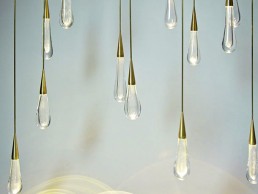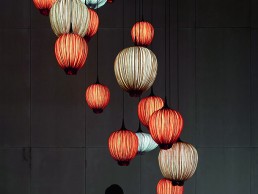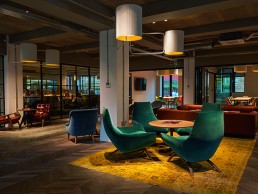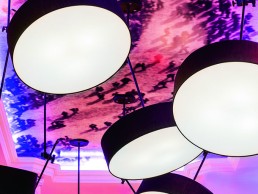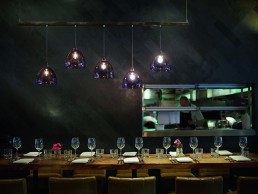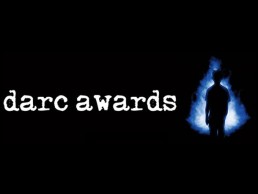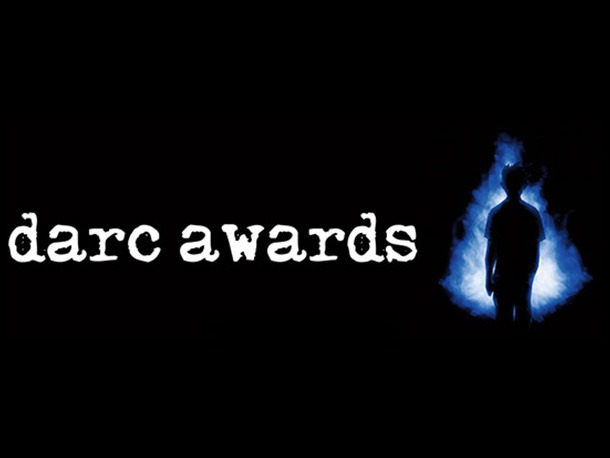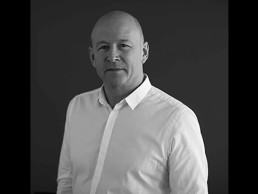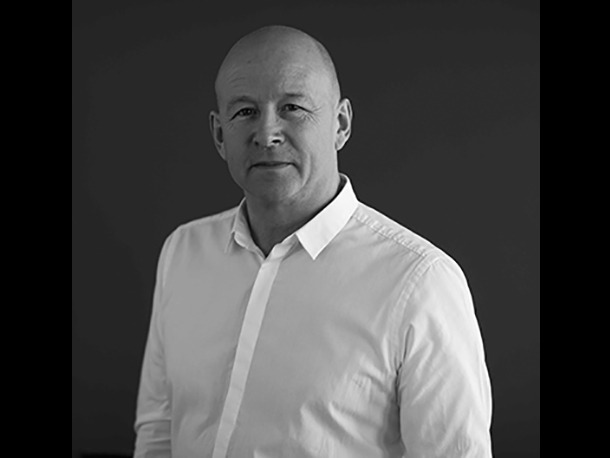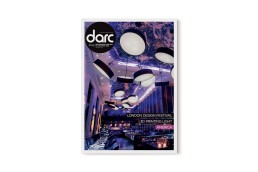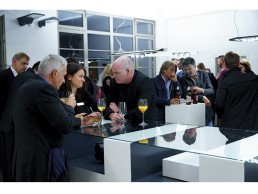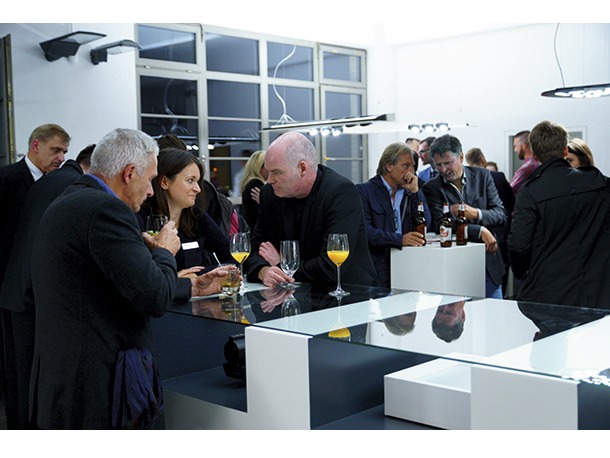A Fresh Dimension
Rees Calder of London-based 3D printing specialist iMakr explains the processes and potential applications of an increasingly accessible technology.
3D printing is here to stay. While the technology has been around since the early ‘80s when it was introduced to the world by Stratasys, it has been enjoying something of a second wave recently as we have seen a number of key patents expire, leading to the rapid proliferation of the technology through both industry and open source communities, being made more readily available than ever before. This has resulted in a rapid reduction in cost of printers, as well as ever increasing speed and reliability. We are fast approaching - and in many cases already have - a time when the general consumer will be able to quickly and comfortably use a 3D printer in their home, for less than the price of a MacBook. What does this mean? This is a big question and not all that easy to answer.
Many have lauded 3D printing as the ‘Next big thing’, ‘The pinnacle of disruptive technology’ and have stated how it is going to alter the face of reality as we know it. While this may be true to an extent, it is important to understand that 3D printing in isolation will likely do none of these things, but rather it is the way in which it is integrated with existing technologies and ideas that will have the most significant impact on our lives.
3D printing has been applied in so many spheres already, from large scale construction to incredibly small scale medical applications, and yet it seems we are only beginning to realise its true potential. 3D printing is a tool. Just as the computer has facilitated a massive surge in productivity for humanity, 3D printing is set to do the same but it won’t happen on its own, it will be up to us to determine the best ways to apply this technology, and fully explore its capabilities.
In terms of aesthetics, this is an area where 3D printing is really thriving, allowing for the creation of innovative new products and designs that have previously been unrealisable through traditional means, or simply too costly to make in any other way. If we examine something like decorative lighting we are able to quickly identify how 3D printing is enabling innovation in a number of ways. Firstly, 3D printing is a great step forward in the way we are now able to create ‘impossible shapes’ or shapes that one would be unable to produce through traditional means without producing the object in multiple parts and having unsightly seam lines – something like the Orbicular lamp by Nervous System (see overleaf) is a prime example.
Complexity means nothing to a 3D printer, which is a truly remarkable aspect of the technology. This is allowing people to create incredibly intricate designs without having to worry about how they will actually go about producing them; production is as simple as sending the file to print, waiting for it to complete and then cleaning it up.
A major benefit of this is that the printer acts on its own. Once you have set something off to print you are free to continue working on other parts of the project. On top of this all of a designer’s work can be stored digitally, allowing them worldwide access to their cloud-based creations. This is going to have a massive impact on the way we share work and collaborate.
Using 3D printing makes many options available to you - largely depending on the type of 3D printing technology you employ and the final result you are looking for. SLS technology uses ceramic powder which is sintered; one can obtain full colour, highly detailed prints using this method, although these can be quite brittle – again the guys at Nervous System make great use of SLS (selective laser sintering) technology in their designs.
FDM (fused deposition modelling) technology on the other hand lays down plastic one layer at a time, these prints are more robust but you are limited to only one or two colours. FDM printers are cheaper by many orders of magnitude and allow one to produce designs quickly and affordably - such as the Steamlined Desk Lamp by Kirby Downey (see overleaf), printed in one piece at a cost of around £3 - many such designs are now available to download from 3D object sharing sites like MyMiniFactory.com for free, giving even non-designers the ability to print functional objects relatively hassle free.
We have barely scratched the surface of what this technology is capable of. The coming years will bring with it innovation on an unprecedented scale and we will see 3D printing being incorporated within the art and design world to the point where it is simply just another tool and no longer a novelty. When the world’s most creative minds have fluid and easy access to 3D printing, there really are no limits to what can be produced.
To see a selection of the more innovative lighting pieces that use 3D printing technology, a number are on display at the iMakr 3D Printing Store in London (79 Clerkenwell Road, EC1R 5AR), as well as numerous other 3D printed objects guaranteed to make your jaw drop. If you would be interested in collaborating on a project, or think you might be able to use 3D printing in your work, contact info@imakr.com
www.imakr.com
The Pour, US
DH Liberty worked with UK-based glass blowers to create an impressive chandelier that resembles falling rain. Named ‘The Pour’, the fixture has been installed in New York’s Tribeca.
When DH Liberty were commissioned to create a light feature for a house in New York’s trendy Tribeca district, they were met by a site with an industrial character with exposed metal columns on either end of a dropped beam within the living room.
The design brief was to produce a light sculpture that would hang off the existing beam, creating an architectural relationship with the space.
In response to the design brief, ‘The Pour’, a chandelier that mimics falling rain was created. The undulating light sculpture resembles rain drops frozen mid fall, the crystal drops held in place by sculpted brass fittings.
DH Liberty worked with UK-based artisan glass-blowers and metal engineers to create the crystal tear-drops.
The rain drop itself is constructed of two parts: the brass screw cap, which houses the light and the hand-blown crystal. These work together to create golden puddles of light on the floor below.
The name ‘The Pour’ derives from the distinctive shape that the chandelier forms - an exaggeration of the dramatic motion water makes when it pours from a carafe - and in order to summon the true nature of water droplets, no two drops are identical in shape.
Designed by forming a grid mimicking how puddles ripple outward in concentric circles, each teardrop is hung to brass pipes of varying lengths. Placed strategically on the grid, the teardrops lock into a mirrored base, which fits seamlessly between the two existing industrial columns, creating the teardrop reflections.
The chandelier echoes rain frozen in time, bringing a sense of nature and the outdoors into an industrial setting.
Nafis Restaurant, Israel
Aqua creations took inspiration from the night sky to create a fresh focal point for Nafis restaurant in Rishon Lezion’s entertainment district.
Nafis restaurant sits within the thriving entertainment district of Mabat in Rishon Lezion, Israel’s fourth largest city, located just a few miles to the south of Tel Aviv. In May this year, the restaurant’s owners commissioned a new light feature to fill the atrium space that cuts through the venue’s two floors - providing a visual link between the two.
After seeing images of ‘Pyramid’, a super-sized silk pendant piece installed at a venue in Las Vegas, they contacted its maker Aqua Creations to request a piece that would deliver a similar ‘wow’ factor.
The design team at Aqua responded with ‘The Silky Way’, a combination of pendant pieces from the company’s existing portfolio, brought together in a unique configuration. In total, twenty shades were used: five Redwood coloured Dippa pendants alongside twelve of its Rust coloured sibling, the Dippa Son, and three Silver Suuria pieces. Each comprises a skin of pleated, pure silk stretched over a metal frame, with CFL lamps at its centre to give the installation its gentle glow.
As the name suggests, this seemingly random configuration of pieces was inspired by the Milky Way, that thick streak of stars of different sizes and brightnesses that together form a single harmonious presence in the sky. By abstracting this idea and translating it for this indoor atrium, Aqua Creations provided a thematic link with the night outside.
British Film Institute, UK
A new restaurant at the British Film Institute’s London headquarters boasts bespoke lighting by .PSLAB, designed to evoke the style and drama of classic cinematography.
The British Film Institute headquarters - located in the heart of London’s Fitzrovia district - is in many ways the beating heart of the UK film industry. Home to the protectors of the national film archive, arbiters of UK film funding and organisers of the London Film Festival, the building on Tottenham Court Road recently gained a new dining space, Stephen Street Kitchen.
Designed in collaboration with Benugo and Softroom Architects, the new venue combines a relaxed, stylish dining experience with access to the BFI’s private screening rooms, making it an ideal feeder space for special events.
Bespoke light fittings were created for the space by Beirut-based fixture specialists .PSLAB. Elegant, white-and-brass insertions, custom-designed and fabricated by .PSLAB, introduce an interplay of light and space that forms the basis of cinematic art. While its dreamlike shape is somehow evocative of classic Hollywood, the golden light produced provides a warm glow to the rugged concrete ceiling, raw hardwood floor, and streamlined furniture within the space.
The fixtures are repeated in different formats throughout the venue both within the restaurant and attached to its exterior.
All fixtures were produced using a manual, recto/verso bending technique applied to corrugated brass sheets. The resulting cylinders are given a powder-coated exterior finish, while the natural brass interiors are left to create a burnished glow. These pieces are finally hinge-mounted to the columns, providing the space with a modular aspect, allowing the light scheme to be subtly manipulated according to the desired mood.
The design of these cylinders is echoed in the large separators placed between the couch seating booths. Utilising a smaller-scale version of the column pieces, these table lamps are finished in brass and are outfitted with a custom black base, lending a touch of film noir to the dining experience.
The corrugated drum finds a third iteration in the meeting room lighting, in which the cylinders are affixed directly to the ceiling in quadruplets.
In combination, the fixtures provide a fitting elegance and drama to match the work of the BFI above and below.
www.pslab.net
www.softroom.com
America Restaurant, US
A bold installation of bespoke lighting drums provide style and drama for America Restaurant, the new venue at the top of Toronto’s Trump Tower.
When entertainment kingpins Charles Khabouth (INK Entertainment CEO) and restaurateurs Oliver & Bonacini took over the 31st Floor of Toronto’s Trump Tower, their ambitions were clear: to rebrand and reconfigure the existing restaurant, Stock, into a more dynamic, entertainment-driven space.
Although Stock, which opened in 2012, had a stylishly conservative aesthetic, the new owners wanted to create a venue that would deliver a sense of fun while continuing to cater to a more mature audience. The style, explained Michael Bonacini, would be “Gutsy, fun, enjoyable, exciting”. It would, said Khabouth, be designed to attract an “older, more refined and sophisticated clientele.”
The partnership turned to a Toronto-based design firm to produce an interior that would deliver the right tone for the venue’s new life under a new identity: America Restaurant. Bold elements were introduced to give the space a sense of vibrancy; striking, large-scale canvases line the walls and a bespoke installation of lighting pieces run the length of the ceiling. Lighting design and manufacturer VISO was commissioned to create this specialist lighting. From the initial sketches, VISO provided project consultation to ground the conceptual design, before engineering and manufacturing the finished pieces.
The installation comprises nineteen large drum lights of varying diameters, all 10” deep, that hang from the 25-foot ceiling on articulated, matte black metal arms. Set at a 150º angle, these arms allow each drum head to be carefully positioned to achieve the desired look. Each circular drum is covered in black linen fabric with two white chintz fabric diffusers, one on the top and bottom. Hanging at different heights in a staggered arrangement, they seem both chaotic and chic as they strike a stylish pose from above.
An additional oversized drum, 5ft in diameter and 15 inches deep, hangs above the reception desk, providing an open-faced welcome to diners as they arrive.
The restaurant serves from breakfast through to supper each day, transforming into a more relaxed, supper-club style space on Thursday, Friday and Saturday nights.
The custom light fixtures are fitted with LED lamps that deliver both smooth dimming and a range of colour changing options, allowing the operators to subtly manipulate the mood of the space. This was demonstrated to fine effect during the Toronto International Film Festival (TIFF), which provided the perfect backdrop to the grand opening of America. Indeed the decision to open during the festival provided perhaps the most impressive element to the installation story: an intense five-day build time. All custom lighting, furniture and art pieces had to be completed on time and in such a way that they would fit inside the Trump Tower cargo elevator – the only access to the 31st floor space.
“Time for construction and testing was tight and the VISO team had to work around the clock to execute on such a short deadline,” recalls VISO CEO and head designer Filipe Lisboa. “The arms had to be strong enough to lift the drum lights in an upward tilt, which was a fun challenge for the team in such a short amount of time. Despite the time constraint, VISO managed to deliver beautiful, functioning and safe lighting installations.”
Within days of opening, stars of the big screen were to be found gracing the new space – a suitably high profile beginning for Toronto’s freshest entertainment experience.
Neighbourhood Restaurant, UK
A chic new addition to Manchester’s bar scene, Neighbourhood takes inspiration from New York’s best to create a blend of high-end style and friendly local character.
The city of Manchester in the UK’s northwest has long enjoyed a reputation for its vibrant club and bar scene. From the day the iconic, Ben Kelly-designed Dry Bar opened its doors in 1989, owners and operators across the city have striven to deliver fresh, innovative, stylish spaces. Neighbourhood continues this tradition. The latest bar to join Manchester’s evolving Spinningfields district, Neighbourhood matches the high-end finish that has become a standard for the venues in the area, but with an added depth of character. The space evokes the warmth and spirit of a Manhattan eatery, reimagined for a Mancunian clientele.
UK entrepreneur brought in award-winning designer Edwin Pickett to convert a timber-clad shell on the edge of Spinningfields into a flagship restaurant space. Hitchen’s love of New York bars and restaurants informed the direction of the design; diners would be transported across the Atlantic for a night of glamour and style.
To successfully deliver the right aesthetic, each element of the design came under scrutiny. “I really wanted to make the restaurant as authentic as possible, so everything from the lighting, the décor and the seating arrangements have been carefully chosen to give that New York feel,” explains Pickett.
As part of the specification process, Tyson Lighting were brought in to help select the right decorative lighting for the job. Tyson captured the essence of NYC’s industrial glamour by treating each area of the restaurant as an individual ‘borough’. The project evolved throughout production, involving a vast range of bespoke fittings, that in turn required a careful selection process by Tyson.
“From a design perspective we chose some beautiful pieces from Curiousa & Curiousa, whom we chose due to exceptional quality of the glass,” says Pickett. “Cheaper alternatives were available, however, spending money in the right places on a project of this magnitude is what gives it the edge on the competition, in an incredibly competitive market.”
Curiousa’s glass shades adorn the bar, the balcony and the main dining area, as well as the restaurant’s plush, upholstered booths, establishing a unique, ornate and authentic lighting scheme. “Being the most popular bar and restaurant in Manchester for the past few months – it proves buying the best you can afford, when it comes to decorative lighting is money well spent.”
darc awards launched
(International) - New international architectural and decorative lighting design awards launched in collaboration with Light Collective. Oscars style peer-to-peer concept and unique darc night event set to be game changer.
Leading international lighting design publications mondo*arc and darc have teamed up with creative consultants Light Collective to create the darc awards, a unique international architectural and decorative lighting design awards concept. The launch party will take place at the incredible arts space Dilston Grove in Southwark, London on February 5th 2015 featuring a special lighting scheme by Light Collective and will also feature an animation by Kerem Asfuroglu of Speirs + Major with his Dark Source series. The darc awards process will culminate in darc night in London in September 2015.
“With our database of over 1,000 international lighting design practices, as well as interior designers and architects, there is a unique opportunity for every practice to get involved in the awards process,” commented Paul James, awards director and publishing editor of mondo*arc and darc. “We intend to make the darc awards the most accessible and global awards programme ever - after the shortlists have been chosen by an expert panel of international lighting designers, each of the 1,000+ lighting design practices and their designers will be invited to vote on their favourite projects via our specially developed website. Using the model developed by the Oscars where all members vote on their peers work, the darc awards will give every designer a vote, making this the only truly peer-to-peer lighting design awards in the world.”
All the projects and the companies who have submitted to the awards will be present on the website so that, over time, the darc awards website becomes a comprehensive online lighting design resource that can be used by designers and clients alike for inspiration and promotion. There will also be product categories (two architectural and one decorative) that will follow the same philosophy resulting in a comprehensive online database of products. The products will be voted on by the very same lighting designers who are looking to use them in projects.
Martin Lupton and Sharon Stammers of Light Collective commented: “Having been involved in many lighting awards programs over many years, this is a great opportunity to build on all of those experiences and try to create a different version of celebrating the best of lighting design where the judging is in the hands of everybody. Helping to shape darc night in collaboration with mondo*arc has given us a chance to create an awards ceremony that is by the people, for the people - it’s the Oscars of lighting design!”
High end lighting manufacturers partnering the awards so far include Lucent, Innermost, Megaman, LSE Lighting and KKDC. More announcements will be made shortly. Each partner will be given the opportunity to collaborate with lighting designers to create a stunning installation in the awards venue via a series of lighting schemes as part of darc night in September 2015, an atmospheric party in a unique venue in London with light art and street food. This breaks all the awards rules and will be unlike any other awards ceremony to date.
The darc awards has been welcomed by the lighting design profession. Nick Hoggett, Partner at dpa lighting consultants, said: “I feel the darc night concept is excellent because the projects will be assessed by a wide group of international independent lighting designers and established light artists. This will reflect a truly global opinion of well informed and experienced practitioners engaging many people in the judging process rather than the normal select few. I know the team behind this will deliver something completely different and special which will be refreshing amongst the plethora of awards programmes that feel so similar.”
mondo*arc and darc magazines are members of Lighting-Related Organizations (L-RO), a global professional community of people who work with light and lighting in the built environment, and is part of the United Nations - International Year of Light and Light-based Technologies 2015 (IYL2015). The darc awards and darc night will be part of the IYL2015 related activities program and will be promoted by the L-RO to raise awareness for the lighting design profession and showcase the importance and beauty of light.
Equity Crowd Funding Expands Terence Woodgate Lighting
(UK) Award-winning industrial designer Terence Woodgate has launched an equity crowd funding campaign to support the expansion of Terence Woodgate Lighting.
The equity crowd funding initiative to raise £150K in return for a 17% share in the business is now live on online equity crowd funding platform Crowdcube.
Launched in February 2014, Terence Woodgate Lighting is spearheaded by Woodgate himself, a Royal Designer for Industry (RDI) with over 25 years' experience in lighting design and manufacture. With few light fittings designed around LEDs in the current market, Terence Woodgate Lighting focuses on designing and producing lighting collections for use with LEDs.
The phase-out of incandescent bulbs, the growing level of public awareness in reducing energy consumption to combat climate change, and the possibilities opened by the digital connectivity of LED technology led Woodgate to identify the opportunity for a design-led company focusing on innovative lighting that maximises the benefits of LED technology.
Woodgate commented: “I launched my lighting company because I believed in the huge potential of LED technology, particularly with the increasing digitalisation of our homes and I saw an opportunity to marry design and technology. The success we’ve enjoyed to date has backed up this belief and we’re now seeking to use equity crowd funding to raise investment to fuel our growth. Equity crowd funding offers an exciting and democratic way for anyone to invest and we’re very excited by this chance to share our plans with a new audience.”
ISSUE NINE
INSIDE ISSUE #09:
Postcard //
Neighbourhood • Manchester //
America Restaurant • Toronto //
Nook • Palo Alto //
Stephen Street Kitchen • London //
Nafis • Rishon Lezion //
Tribeca House • New York //
Folio: Conran + Partners //
Comment: 3D Printing //
3D Printing Lighting Gallery //
Calendarc //
Maison & Object • Paris //
Interieur • Kortrijk //
Designjunction • London //
100% Design • London //
Tent • London //
Decorex • London //
Around London Design Festival //
If…
FLASH DQ Gallery Berlin Grand Opening
(Germany) LUG Light Factory held the grand opening of its new office and showroom, FLASH DQ Gallery in Berlin, Germany, last month.
The showroom was officially opened by Ryszard Wtorkowski, President of LUG Light Factory who declared the company’s commitment to developing its operations in Germany and cooperation with German architects and designers.
The opening event was an opportunity to not only present Lug Light Factory and its luminaries but, to meet and network with guests from the industry. During the event, LUG also shared some of its knowledge and passion for lighting in presentations given by Mariusz Ejsmont, Technical Director and Paweł Kmiecik, Head Architect.
The FLASH DQ Gallery in Berlin is a place for architects, interior designers and other professionals interested in state-of-the-art lighting solutions and LED technology to explore the collections of LUG and FLASH DQ brands.
Germany is the sixth country to host a LUG Light Factory showroom with others found in Warsaw, London, Paris, Dubai and Sao Paulo.




